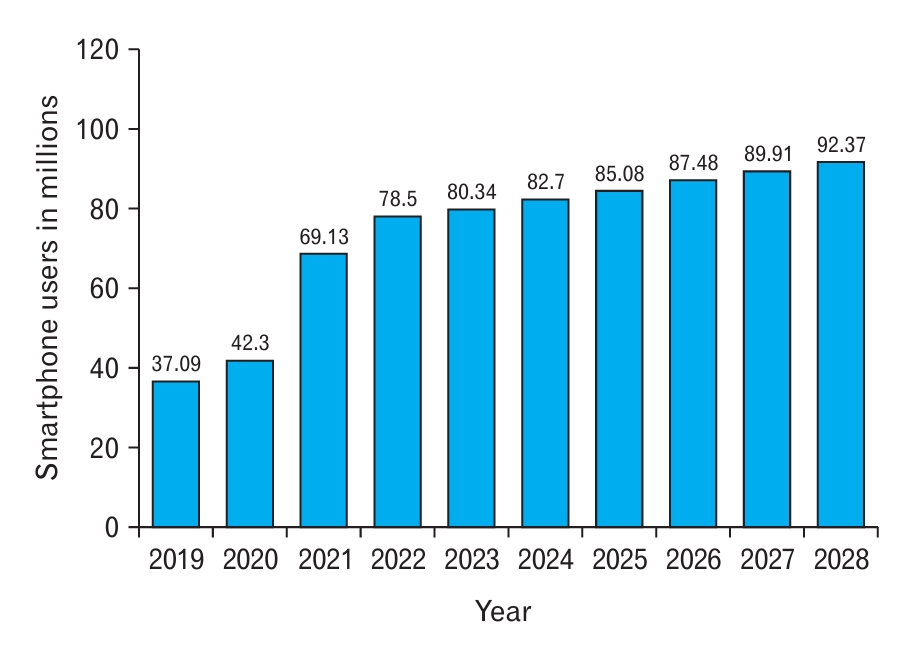 |
 |
- Search
| Korean J Fam Med > Volume 45(2); 2024 > Article |
|
To the editor,
I read the recent editorial published in this journal on smartphone use and physical activity among adolescents with interest. The Editor-in-Chief compiled various published studies on the issue and arrived at the conclusion that excessive use of smartphones can reduce physical activity, which can in turn affect the general well-being of adolescents [1]. I firmly support this claim and justify it by presenting similar results in the Philippine context. In addition, this paper proposes concrete interventions to address this alarming issue.
Smartphones have become popular and widely used global communication tools. Aside from its use in communication, its popularity stems from its diverse functions, such as business transactions, research, entertainment, and other activities that consume a lot of time. A study revealed that the number of smartphone users in the Philippines is forecasted to continuously increase by 12 million (+14.94%) between 2024 and 2028. After the ninth consecutive year of increase, the smartphone user base is estimated to reach 92.37 million users, with a new peak in 2028. Notably, smartphone use has continuously increased over the past years in the Philippines (Figure 1) [2].
Another recent study showed that Filipinos have the highest average screen time spent on phones, and rank consistently high for average screen time on computers, social media, and gaming among 50 countries. The study results showed that Filipinos spend nearly a third of their day (32.53%) on their phones, narrowly edging Brazil at 32.46% [3]. This showed how “dependent” Filipinos are on their smartphones, may it be for leisure, work, or school purposes.
Extended smartphone usage reduces physical activity, and many Filipino adolescents suffer from adverse health owing to this. According to the 2022 Philippine Report Card on Physical Activity for Children and Adolescents, Filipino youths and adolescents were among the most physically inactive in the world, with only 15.4% meeting the global recommended level of physical activity. Insufficient physical activity among adults and adolescents is a global health problem according to the World Health Organization, United Nations, and other organizations [4]. What is more concerning is the emergence of a condition called nomophobia. The term NOMOPHOBIA or “No Mobile Phone Phobia” is used to describe a psychological condition in which people fear being detached from their mobile phone connectivity, as stated in the Diagnostic and Statistical Manual of Mental Disorders, 4th edition [5]. Feelings of stress and anxiety or even of fear and panic are associated with this condition.
To address this issue, we should not aim to prevent adolescents from using their smartphones completely, as it is undoubtedly necessary for everyday affairs. However, providing more opportunities for adolescents to become physically active could make a significant difference. This, however, would require different institutions to take the lead. The government should build safer public places and sidewalks where adolescents can walk, jog, bike, and do various types of exercise. Schools and other educational institutions must integrate sports-related courses into their curricula and organize more sports leagues/competitions to enhance healthy competition. Finally, the church and other religious groups/organizations should promote physical activities like “walk-for-a-cause,” religious interpretative dance, Zumba, yoga, and other meditative practices. It is important to note that humans should be the masters of gadgets and not their slaves.
Figure. 1.
Number of smartphone users in the Philippines from 2019-2028 (in millions). From Statista Research Department. Smartphone penetration rate as share of the population in the Philippines from 2019 to 2028 [Internet]. New York (NY): Statista Research Department; 2023 [cited 2023 Oct 14]. Available from: https://www.statista.com/statistics/625427/smartphone-user-penetration-in-philippines/ [2].

REFERENCES
1. Kim SY. Does excessive smartphone use reduce physical activity in adolescents? Korean J Fam Med 2023;44:247-8.




2. Statista Research Department. Smartphone penetration rate as share of the population in the Philippines from 2019 to 2028 [Internet]. New York (NY): Statista Research Department; 2023 [cited 2023 Oct 14]. Available from: https://www.statista.com/statistics/625427/smartphone-user-penetration-in-philippines/
3. Purnell K. The Philippines has highest average screen time on phones: study. Philstar.com [Internet]. 2023 May 21 [cited 2023 Oct 12]. Available from: https://www.philstar.com/lifestyle/gadgets/2023/05/21/2267517/philippines-has-highest-average-screen-time-phones-study
4. Good Neighbors International Philippines. Let’s all move for good: helping address the insufficient physical activity of young people [Internet]. Quezon City: Good Neighbors International Philippines; 2023 [cited 2023 Oct 14]. Available from: https://goodneighbors.ph/lets-all-move-for-good-helping-address-the-insufficient-physical-activity-of-young-people/
- TOOLS
-
METRICS

-
- 0 Crossref
- Scopus
- 995 View
- 14 Download
- Related articles in KJFM
-
Does Excessive Smartphone Use Reduce Physical Activity in Adolescents?2023 September;44(5)
Current Status of Physical Activity in South Korea2022 July;43(4)
Excessive and Problematic Smartphone Use and Poor Mental Health in Adolescents2020 March;41(2)
The Effect of Physical Activity on Colorectal Polyps.2005 July;26(7)






